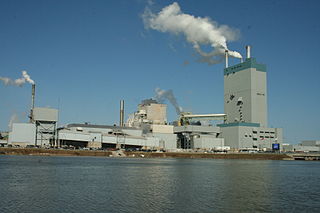Related Research Articles

Dryden, originally known as New Prospect, is the second-largest city in the Kenora District of Northwestern Ontario, Canada, located on Wabigoon Lake. It is the least populous community in Ontario incorporated as a city. The City of Dryden had a population of 7,749 and its population centre had a population of 5,586 in 2016.

The Saulteaux, otherwise known as the Plains Ojibwe, are a First Nations band government in Ontario, Manitoba, Saskatchewan, Alberta and British Columbia, Canada. They are a branch of the Ojibwe who pushed west. They formed a mixed culture of woodlands and plains Indigenous customs and traditions.

Minamata disease is a neurological disease caused by severe mercury poisoning. Signs and symptoms include ataxia, numbness in the hands and feet, general muscle weakness, loss of peripheral vision, and damage to hearing and speech. In extreme cases, insanity, paralysis, coma, and death follow within weeks of the onset of symptoms. A congenital form of the disease can also affect fetuses in the womb and may cause cerebral palsy.

Mercury poisoning is a type of metal poisoning due to exposure to mercury. Symptoms depend upon the type, dose, method, and duration of exposure. They may include muscle weakness, poor coordination, numbness in the hands and feet, skin rashes, anxiety, memory problems, trouble speaking, trouble hearing, or trouble seeing. High-level exposure to methylmercury is known as Minamata disease. Methylmercury exposure in children may result in acrodynia in which the skin becomes pink and peels. Long-term complications may include kidney problems and decreased intelligence. The effects of long-term low-dose exposure to methylmercury are unclear.

The Wabigoon River is a river in Kenora District in northwestern Ontario, Canada. It flows from Raleigh Lake past Dryden, Ontario on Wabigoon Lake to join the English River. The name "Wabigoon" comes from the Ojibwe waabigon, "marigold", or waabi-miigwan, "white feather".
Treaty 3 was an agreement entered into on October 3, 1873, by Chief Mikiseesis on behalf of the Ojibwe First Nations and Queen Victoria. The treaty involved a vast tract of Ojibwe territory, including large parts of what is now northwestern Ontario and a small part of eastern Manitoba, to the Government of Canada. Treaty 3 also provided for rights for the Waasaakode Anishinaabe and other Ojibwe, through a series of agreements signed over the next year. The treaty was modified in 1875 when Nicolas Chatelain negotiated an adhesion that created a reserve, surveyed as reserve 16A, for Metis families connected to Mikiseesis' Rainy Lake Band. Reserve 16A and the Rainy Lake Band reserve were unified in 1967.
Asubpeeschoseewagong First Nation is an Ojibwe First Nations band government who inhabit northern Kenora in Ontario, Canada. Their landbase is the 4,145 ha English River 21 Indian Reserve. It has a registered population of 1,595 as of October 2019, of which the on-reserve population was 971. As of October 2020, the community had a population of approximately 1,200. They are a signatory to Treaty 3.

The Chisso Corporation, since 2012 reorganized as JNC, is a Japanese chemical company. It is an important supplier of liquid crystal used for LCDs, but is best known for its role in the 34-year-long pollution of the water supply in Minamata, Japan that led to thousands of deaths and victims of disease.
The four big pollution diseases of Japan were a group of man-made diseases all caused by environmental pollution due to improper handling of industrial wastes by Japanese corporations. The first occurred in 1912, and the other three occurred in the 1950s and 1960s.
Niigata Minamata disease is a neurological syndrome caused by severe mercury poisoning. Identical in symptoms to the original outbreak of Minamata disease in Kumamoto Prefecture, the second outbreak in Niigata Prefecture was confirmed with the same name in 1965. The disease was caused by severe mercury poisoning, the source of which was methylmercury released in the wastewater from mercury sulfate-catalysed acetaldehyde production at the Showa Electrical Company's chemical plant in Kanose village. This highly toxic compound was released untreated into the Agano River where it bioaccumulated up the food chain, contaminating fish which when eaten by local people caused symptoms including ataxia, numbness in the hands and feet, general muscle weakness, narrowing of the field of vision and damage to hearing and speech.
Wabaseemoong Independent Nations or more fully as the Wabaseemoong Independent Nations of One Man Lake, Swan Lake and Whitedog, is an Ojibway First Nation band government who reside 120 km northwest of Kenora, Ontario and 13 kilometres (8.1 mi) east of the Ontario-Manitoba border of northwestern Ontario, Canada. As of December 2018, the First Nation had a population of 2,000 registered people, of which their on-Reserve population was 1200 registered members and approximately 100 non-Band members.
Grand Council of Treaty 3 (GCT3) is a political organization representing 24 First Nation communities across Treaty 3 areas of northern Ontario and southeastern Manitoba, Canada, and four additional First Nations, specifically in regard to their Treaty rights.

The Dryden pulp mill, also known as the Reed Mill, is a paper and pulp mill in Dryden, Ontario. During the 1960s and 70s, mercury poisoning from the mill caused one of Canada's worst environmental disasters: Dryden Chemicals Ltd dumped mercury into the English-Wabigoon River, upstream of Grassy Narrows First Nation, poisoning the fish which were their staple food. Members of the Grassy Narrows and the Whitedog communities downstream from the mill suffered severe mercury poisoning.
Mercury is a poisonous element found in various forms in Canada. It can be emitted in the atmosphere naturally and anthropogenically, the main cause of mercury emission in the environment. Mercury pollution has become a sensitive issue in Canada for the past few decades and many steps have been taken for prevention at local, national, and international levels. It has been found to have various negative health and environmental effects. Methylmercury is the most toxic form of mercury which is easily accessible as well as digestible by living organisms and it is this form of mercury causing serious harm to human and wildlife health.

Brian Branfireun is a Canadian environmental scientist. He held a Canada Research Chair (2010-2020) and is a professor at Western University. He studied climate change and directed a laboratory in Western's Biotron for the study of speciated trace metals in the environment such as mercury and arsenic.
In Canada, First Nations communities have been under long-term drinking water advisories (DWAs) for decades. A long-term drinking water advisory is an advisory that has been in place for over a year.

Mercury contamination in Grassy Narrows was an uncontrolled discharge of between 9,000 kilograms (20,000 lb) and 11,000 kilograms (24,000 lb) of mercury from the Dryden Mill's chloralkali plant in Dryden into the headwaters of the Wabigoon River in the Kenora District of Northwestern Ontario from 1962 until 1970. It was described as "one of the worst cases of environmental poisoning in Canadian history." The contamination poisoned many people in the Grassy Narrows First Nation and Whitedog First Nation communities
The Royal Commission on the Northern Environment was established by the Government of Ontario with J. E. J. Fahlgren as Commissioner. The final report and recommendations were submitted to the Ontario Ministry of the Attorney General on June 28, 1985.
Water pollution in Canada is generally local and regional in water-rich Canada, and most Canadians have "access to sufficient, affordable, and safe drinking water and adequate sanitation." Water pollution in Canada is caused by municipal sewage, urban runoff, industrial pollution and industrial waste, agricultural pollution, inadequate water infrastructure. This is a long-term threat in Canada due to "population growth, economic development, climate change, and scarce fresh water supplies in certain parts of the country."
References
- 1 2 3 D'ltri, P A; D'ltri, F M (January 1978). "Mercury contamination: A human tragedy". Environmental Management. 2 (1): 3–16. Bibcode:1978EnMan...2....3D. doi:10.1007/BF01866442. ISSN 1432-1009. S2CID 153666705.
- 1 2 3 4 McDonald, A. "Indigenous peoples' vulnerabilities exposed: Lessons learned from Canada's Minamata incident: An Environmental analysis based on the case study of methyl-mercury pollution in northwestern Ontario, Canada" (PDF). JACS Conference 2007: Japanese Association for Canadian Studies. Archived from the original (PDF) on 2007-10-14. Retrieved 2007-12-14.
{{cite journal}}: Cite journal requires|journal=(help)CS1 maint: location (link) - ↑ "Caught in a toxic web, Canadian natives are alarmed by a shortage of sons" Archived 2012-02-09 at the Wayback Machine . AP News archive
- ↑ Mercury Poisoning. Vol. CX16. Quaker Committee for Native Concerns, Toronto, Canada. 1976. Retrieved 2007-12-14.
- 1 2 3 Harada, M, Fujino, T, Akagi, T, and Nishigaki, S. "Epidemiological and clinical study and historical background of mercury pollution on Indian Reservations in Northwestern Ontario, Canada". Kumamoto University . 26: 169–184.
{{cite journal}}: CS1 maint: multiple names: authors list (link) - ↑ Susan Goldberg (April 19, 2017). "The Town Where Mercury Still Rises". The New York Times. Retrieved April 19, 2017.
- ↑ Forbes, Ryan (2018-08-14). "ODSP now covers mercury poisoning".
- ↑ Loriggio, Paola (2017-02-28). "Chief says mercury still leaking from mill near Grassy Narrows - According to Chief Simon Fobister, a new report suggests there is ongoing contamination from the Dryden, Ont., mill".
- ↑ Forbes, Ryan (2017-10-25). "Mercury legacy 'frightening,'commissioner".
- 1 2 3 "English-Wabigoon River Mercury Compensation". INAC Ontario Region Communications. April 12, 2005. Archived from the original on March 11, 2008. Retrieved March 5, 2021.
- ↑ "New Socialist: Grassy Narrows: History of the fight". Archived from the original on 2008-03-16. Retrieved 2007-10-25.